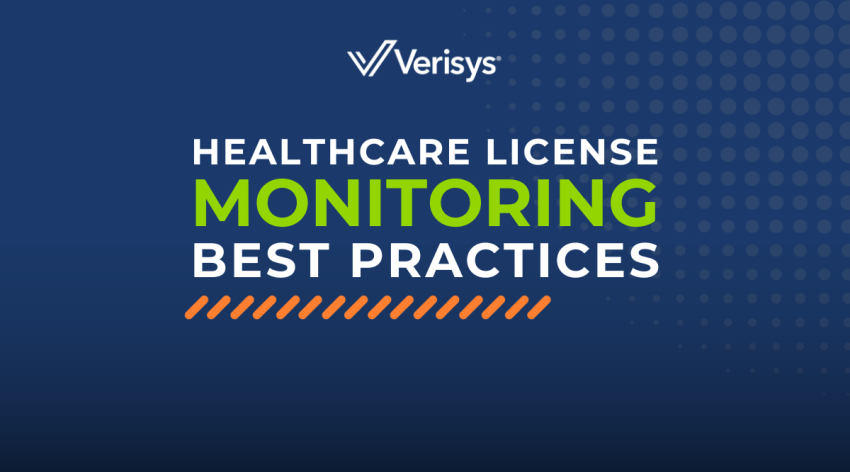– The best resource for monthly healthcare regulatory compliance updates. Compliance Updates: April 2024 Overlook: Licensure Compacts Other Legislation Board Updates Interstate Medical...


Did you know that for every 1,000 licensed healthcare practitioners there will typically be 20 with inactive licenses, 10 with a suspended license, and another six practitioners with either a restricted or revoked license, or on probation? On top of that, among those 1,000 practitioners, there will be 10 with a current or past exclusion, two that are sex offenders, and another two that are patient abusers. How does a healthcare facility find all of these adverse actions? By carefully screening the practitioner and continually monitoring his license.
To stay in compliance with federal and state regulations and to keep patients safe, it’s vital for hospitals and health systems to monitor the licenses of their practitioners for new information that may prevent a physician from practicing. If a practitioner’s license is invalid, suspended, or expired, or if restrictions are placed on a license, healthcare organizations must take steps to halt the treatment of patients until the practitioner gets his license back in good standing. The best way to ensure all practitioner licenses remain in good standing is through continuous healthcare license monitoring.
To set up monitoring of a physician’s license, organizations must first verify the licensing information and credentials of the practitioner. Healthcare facilities must confirm the physician’s graduate and undergraduate degrees, or specialty certifications are valid. These may include a medical doctorate degree from an accredited U.S. or international educational institution, completion of a medical residency program from an Accreditation for Graduate Medical Education (ACGME)-accredited program, and other American Medical Association (AMA) educational requirements for physicians.
Physicians who intend to practice medicine within a specific state must obtain a license to practice from that state. It’s also important to verify board certification, which is awarded by the American Board of Medical Specialties (ABMS) after candidates pass a board-administered examination. ABMS certification should be verified by healthcare organizations to ensure their physicians are certified and in good standing. Restrictions may be placed upon a practitioner’s license for civil or legal violations as well as discipline imposed by the medical board.
In addition to verifying professional credentials, healthcare facilities should also check practitioners against national databases that track exclusions, sanctions, sex and patient abuse, criminal misdemeanors, and felony convictions.
Because the United States does not have a standardized medical system, each state operates its own licensing board. A physician who is licensed in one state will not necessarily be licensed in the neighboring states. All employers should check all applicable databases and licensing boards to make sure that the medical physicians it hires are licensed and current in the state(s) in which they will practice. This is especially true with traveling physicians or those providing telehealth services in more than one state.
All licenses should be checked against the state Board of Medical Examiners for the state in which the medical professional will be practicing. Specialty certifications can be verified with American Allied Health and many other similar organizations nationwide.
Multiple databases should be checked on an ongoing basis to ensure that practitioners’ information is up to date. Monitoring these databases is necessary as new practitioner information is being added all the time. It is the responsibility of the employing facility to make sure that their physicians are keeping their licenses current. Consequences for neglecting to monitor licenses could include steep fines, litigation, loss of reputation, denied claims, and harm to patients.
Each licensed or certified practitioner at your facility must be credentialed. This can be a long and complex process, requiring a significant investment of time and resources. The most successful organizations develop or use standard guidelines they expect their staff to follow.
Your procedures may include items like this list from the Joint Commission:
Although the law does not dictate exactly how organizations should conduct their credentialing process, healthcare facilities are expected to understand the educational and professional requirements for the positions filled by their staff and to verify that physicians’ credentials are valid and in good standing. If they hire or continue to employ medical practitioners without current or valid credentials, they risk fines, penalties, and denied reimbursements for claims.
Although there are many federal exclusion lists and state licensing boards to monitor, it is crucial for healthcare facilities to understand healthcare licensure requirements for each job type and specific practitioner role. Not only do requirements differ from one position to another, but practitioners receive their credentials from many different institutions, and each of these must be contacted for primary source verification. Even if a healthcare facility inadvertently employs a physician without being aware of invalid/expired credentials or current exclusions, they are still liable. Continual monitoring of practitioners’ license information and exclusion status will help prevent this from happening.
Rather than monitoring all these primary sources and databases themselves, many healthcare organizations prefer to use the services of an accredited credentials verification organization (CVO). This allows healthcare facilities to receive accurate, complete, and current information about the credentials of the physicians they hire.
The consequences of allowing a physician with invalid credentials, an expired or impaired license, or sanctions and exclusions are severe. In November 2019 a physician finally surrendered his medical license after years of substance abuse, failed detox programs, and violating the probation put on his license to practice. This is not someone you want practicing in your hospital. With proper monitoring processes in place, individuals like this would be flagged, saving your facility and your patients from harm.
Healthcare facilities committed to providing the highest level of care to their patients should carefully monitor licensing data against state and federal databases to maintain the integrity of their practice.